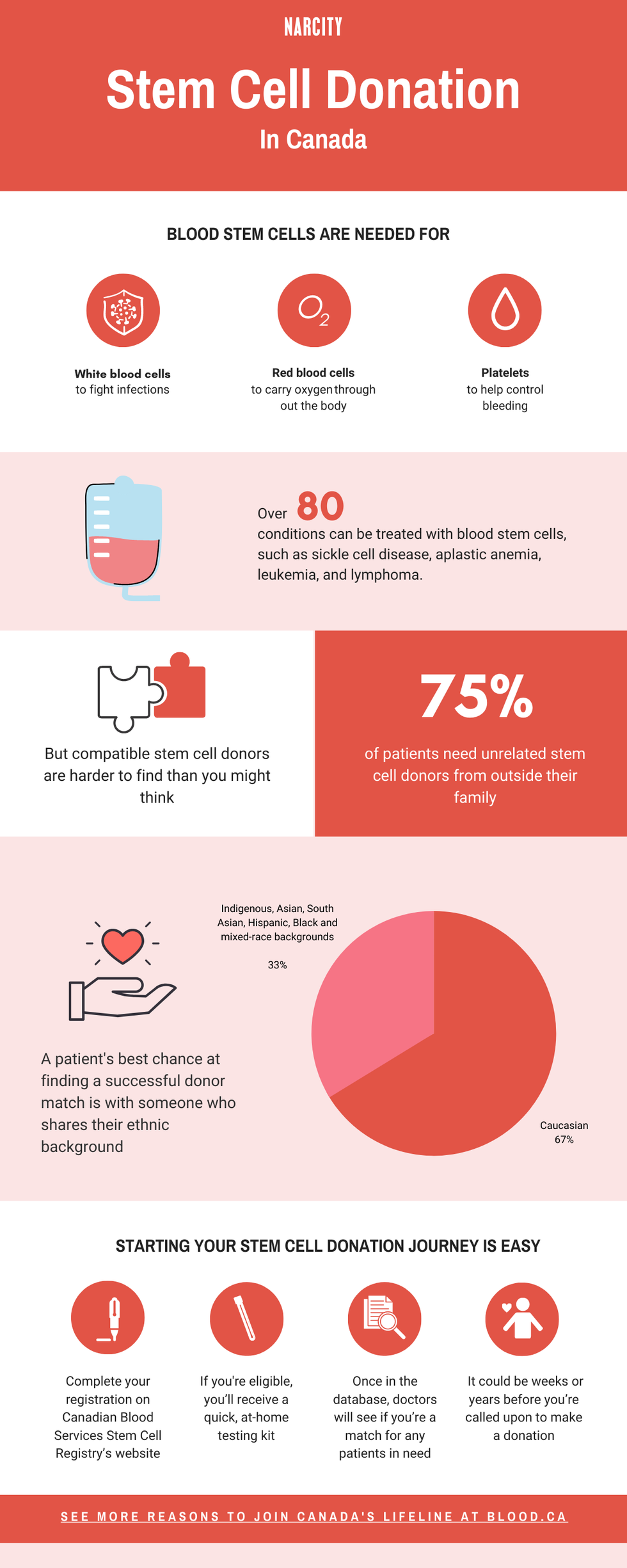Canada's Stem Cell Registry Isn't Diverse Enough, Here's Why That's A Big Problem
When 50% of contacted donors don't follow through, every registration counts.
Among the qualities that Canadians are known for, generosity and helpfulness are at the top of the list.
Shovelling your neighbour's driveway or giving your pal's car a boost might save them some time, but did you know that an act of kindness could save a life?
In Canada, the need for stem cell donors is increasing, and you can help out by joining Canadian Blood Services Stem Cell Registry.
There are currently over 1,000 Canadian patients hoping for a stem cell donor and, if you're aged 17-35, you could be eligible to register and one day be a lifesaving match.
The first step to becoming a donor is easy, and it all starts with registering online.
What Are Stem Cells & Why Is There A Stem Cell Registry?
Stem cells, specifically blood stem cells, are immature cells that can develop into other types of cells in the bloodstream.
Red blood cells (which transport oxygen throughout the body), white blood cells (which help fight infection) and platelets (which help stop bleeding) all come from blood stem cells produced by the body.
They're so vital that stem cell transplants are considered a lifesaving option for patients with cancers and other blood diseases.
In fact, there are over 80 conditions that can be treated with stem cells, such as sickle cell disease and aplastic anemia, as well as leukemia, lymphoma and other blood cancers.
Canadian Blood Services Stem Cell Registry was established because compatible stem cell donors are harder to find than you might think.
Less than 25% of patients find a stem cell match within their own family. This leaves many patients in need searching for unrelated volunteer donors to give them a fighting chance.
As an organization, Canadian Blood Services actively seeks new registrants and does vital work connecting patients in need with matching donors
Patients Need Greater Diversity In The Stem Cell Registry
Right now, Canadian Blood Services Stem Cell Registry is not as diverse as Canada’s population.
Though there are over 400,000 people registered with Canadian Blood Services Stem Cell Registry, only 33% of potential donors come from Indigenous, Asian, South Asian, Hispanic, mixed-race and diverse Black communities.
Patients searching for a donor are more likely to match with someone who shares their ethnicity, which makes it harder for people from these groups to find a donor.
One such patient is Jude, an eight-month-old boy from Edmonton. Jude has chronic granulomatous disease (CGD), a condition that affects his white blood cells and makes it hard for his body to fight infections.
A stem cell transplant could potentially cure Jude, and his best shot for a match is with someone who shares his background, namely Metis, Ukrainian and Portuguese.
Seven-month-old Arend was also diagnosed with CDG just months after his birth. Like Jude, a donor who matches his background (South African and Latvian) could help Arend avoid a future of life-threatening infections that repeatedly land him in hospital.
It's vital to patient care that Canadian Blood Services continues to build a diverse stem cell registry to be able to serve all patients like Jude and Arend.
Diversity In The Stem Cell Registry Isn't The Only Challenge
A shared ethnic background is just one part of the puzzle. Young donors are more likely to lead to positive outcomes for patients receiving transplants, and stem cells from male donors can decrease the possibility of post-transplant complications.
Young donors also remain on the stem cell registry longer (until their 60th birthday, unless they opt out earlier), which further increases the odds that they'll be able to help a stem cell patient down the line.
In short, the need has never been greater for Canadians aged 17-35 from Indigenous, Asian, South Asian, Hispanic, mixed-race and diverse Black communities to join Canadian Blood Services Stem Cell Registry.
Getting Canadians to register as potential stem cell donors is just the beginning. Despite there being over 400,000 people in the registry, Canadian Blood Services told Narcity that only about 50% of those contacted follow through with donating.
Understanding what it means to be a stem cell donor and being on the registry is a long-term commitment. It may take weeks, months or even years before a potential stem cell donor gets the call to donate.
When one matching donor declines, a delay in finding another match – if one can be found – has life-threatening consequences for the patient who's waiting for treatment.
To help remedy this situation, Canadian Blood Services Stem Cell Registry is reaching out to potential donors to check if they’re still committed to donating.
If you’re on the registry and are no longer available to donate stem cells, it's vital that you contact the registry and opt out to help prevent delays in finding a match for patients.
How You Can Register To Become A Stem Cell Donor
Visit Canadian Blood Services Stem Cell Registry’s website to learn more about how stem cell donation works and whether you’re eligible to donate.
If you're eligible, you’ll receive a quick at-home testing kit from Canadian Blood Services, which asks you to swab the inside of your cheeks and send back the sample in the pre-paid envelope provided.
Once in the database, doctors will be able to see if you’re a match for any patients in need. It could be weeks or years before you’re called upon to make a donation. And if you're a match, Canadian Blood Services will be with you every step of the way.
If helping a stranger carry a stroller down the stairs feels good, imagine how great it feels to give the gift of life.
Find out how you can save a life by joining Canadian Blood Services Stem Cell Registry. You can also follow them on Instagram, Facebook, Twitter, and YouTube for more information.
- Over 800 Canadians Need A Stem Cell Donor Match RN & You ... ›
- 7 Reasons Why Stem Cell Donation In Canada Is So Important ... ›


